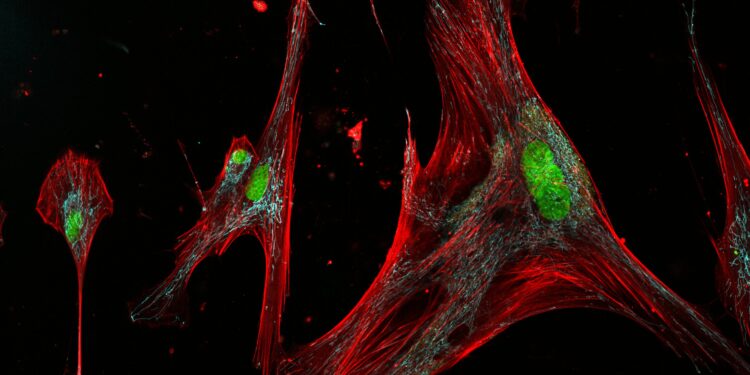Fibroblasts linked to the skin with green and f-actine nuclei in red. Credit: Jude Phillip, Johns Hopkins University
Senescent skin cells, often called zombie cells because they have survived their usefulness without ever completely dying, have existed in the human body as an apparent paradox, causing inflammation and the promotion of diseases while helping the immune system to cure wounds.
New results can explain why: all senescent skin cells are not the same.
Researchers from Johns Hopkins University have identified three subtypes of senescent skin cells with distinct forms, biomarkers and functions – an advance that could offer scientists the ability to target and kill harmful types while leaving useful intact.
The results appear in the newspaper Scientific advances.
“We know that senescent skin cells are different from senescent immune cells or senescent muscle cells. But in a type of cell, senescent cells are often considered the same – in essence, skin cells are senescent or not, for example,” said Jude Phillip, assistant teacher of biomedical genius at Johns Hopkins University.
“But we note that when a skin cell enters senescence, or a zombie type state, the cell could take one of the three different paths, each leading to a slightly different subtype.”
Taking advantage of new advances in automatic learning and imaging technology, the researchers compared the samples of skin cells of 50 healthy donors between 20 and 90 years old who participated in the longitudinal study of Baltimore, the longest study of aging in the United States.
The researchers extracted fibroblasts – cells that produce scaffolding to give fabrics their structure – associated with skin tissues and pushed them towards senescence by damaging their DNA, something that happens with aging. Because senescent cells accumulate naturally as people age, elderly samples contained a mixture of healthy / non-sensitive and senescent fibroblasts.
Using specialized dyes, researchers were able to capture images of the forms of cells and colored elements that are known to indicate the senescent cells. The algorithms developed for this study analyzed the images, measured 87 different physical characteristics for each cell and sorted fibroblasts into groups.
Fibroblasts are available in 11 different forms and sizes, three of which are distinct from senescent skin cells, have noted the researchers. A single subtype of Fibroblast Sénescent, which the researchers named C10, were more widespread in older donors.
In the Petri boxes, each subtype responded differently when exposed to the existing medication patterns designed to target and kill zombie cells. Dasatinib + Quercetine, a medication tested in clinical trials, for example, the most effectively killed the senescent fibroblasts C7 but was limited in the death of the senescent fibroblasts C10 associated with age.
Although additional research is needed to check which fibroblast subtype is harmful and which is useful, the results show that drugs may target a subtype and not others.
“With our new discoveries, we have the tools ready to develop new drugs or therapies that preferentially target the senescence subtype that leads to inflammation and disease as soon as it is identified,” said Phillip.
More precise targeting of senescence could benefit from cancer treatments, the researchers said.
Certain therapies are designed to trigger senescence in cancer cells, converting cancer cells into unscrews into dead zombie cells in water. Although these therapies can stop tumor growth, they leave senescent cells in their wake. Conventional chemotherapy also grow cells like fibroblasts towards senescence as a side effect. The accumulation of senescent cells during treatment can be problematic because these cells can promote inflammation at a time when a patient’s immune system is the most vulnerable.
Patients can benefit from a medication administered after chemotherapy that can sweep the waste, removing harmful senescent cells while leaving useful senescent cells. These types of drugs are called senesrapies.
Then, the researchers plan to examine the senescence subtypes in tissue samples, not only in the bottles and petri boxes, to see how these subtypes could be associated with various skin diseases and with age-associated diseases.
“We hope, with a little more development, our technology will be used to help predict which drugs could work well to target senescent cells that contribute to specific diseases,” said Phillip. “Finally, the dream is to be able to provide more information in a clinical context to help with individual diagnoses and increase health results.”
More information:
Pratik kamat et al, the single cell morphology code for functional subtypes of senescence in the aging of human dermal fibroblasts., Scientific advances (2025). DOI: 10.1126 / SCIADV.ADS1875. www.science.org/doi/10.1126/sciadv.ads1875
Supplied by Johns Hopkins University
Quote: “Zombie” skin cells can be harmful or useful, according to their forms (2025, April 25) recovered on April 25, 2025 from
This document is subject to copyright. In addition to any fair program for private or research purposes, no part can be reproduced without written authorization. The content is provided only for information purposes.


